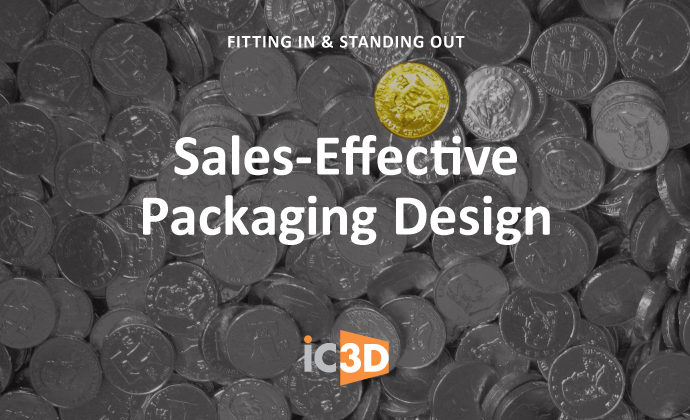Consumer product package design is a paradox. First, a package must “fit in.” Among other things, it must be practical, affordable, efficient for both transport and display, environmentally friendly, and legally compliant. Simultaneously, it must “stand out,” as a compelling sales tool. It’s hard to do both well.
I’ve spent a lot of time in these blogs on the “fitting in” part of the equation—since that’s where iC3D so obviously provides value. It’s good to have a digital packaging workflow that gives multiple stakeholders the ability to make rapid decisions. One example is complex decisions affected by changing Nutrition Facts regulations. However, because I’m not a designer, I’ve spent less time talking about design imperatives.
The good news is there’s plenty of great advice for those who want their product to stand out on the shelf, including a great list of 8 principles of sales-effective packaging design by Packaging World contributor Adam Spriggs. I’ll summarize some of his best points here, but the blog itself is well worth a read.
Sales-Effective Packaging Design
The store shelf is like a very crowded street, with many people, signs, storefronts, and other distractions. To get noticed, both a package and a person must be visually striking. This doesn’t mean loud or obnoxious. It means using colors and other elements designed to attract the eye from a distance. For packaging, that means “do[ing] what hasn’t been done, go for it, stand out,” Spriggs advises. “To sit quietly on shelf is to leave sales on the table.”
Good design also involves serving the information needs of the busy consumer. Spriggs advises designers to visually prioritize the product information. Later, he also points out that packaging’s role is educational. “Assume the shopper knows nothing! Too many brands assume the shopper is willing to or capable of connecting the dots to understand what their products are about,” he warns. “If your product category or segment isn’t represented in at least 50% of the population’s fridges or pantries, go out of your way to provide context.”
Perhaps most importantly, Spriggs advises designers to design with the store in mind. “Sales-effective packaging accounts for the realities of the physical store environment,” he notes. “Frosted-over freezer doors obscure vision, hang-tags intrude upon products stocked on the shelf below, lights cause reflections and shadows, and stocking preferences of retailers vary.”
Designers must understand these factors. In-store realities influence what packaging substrates are used, and where critical messaging is placed.
Visualization is Key
As with the practical, “fit in” aspects of packaging, the “stand out” design components cannot be fully evaluated or improved if they’re only viewed as flat artwork. Even if a skilled packaging designer can mentally visualize how the work will appeal on a store shelf, other members of the team may not. That’s where virtual, 3D modelling is essential.
Fortunately, tools like iC3D make this step an easy one. Good designers can be relied upon to follow the advice of Spriggs and others, but only with the help of 3D ideation can they do so efficiently, in a complex, team context, and at a scale necessary in today’s consumer product environment.






